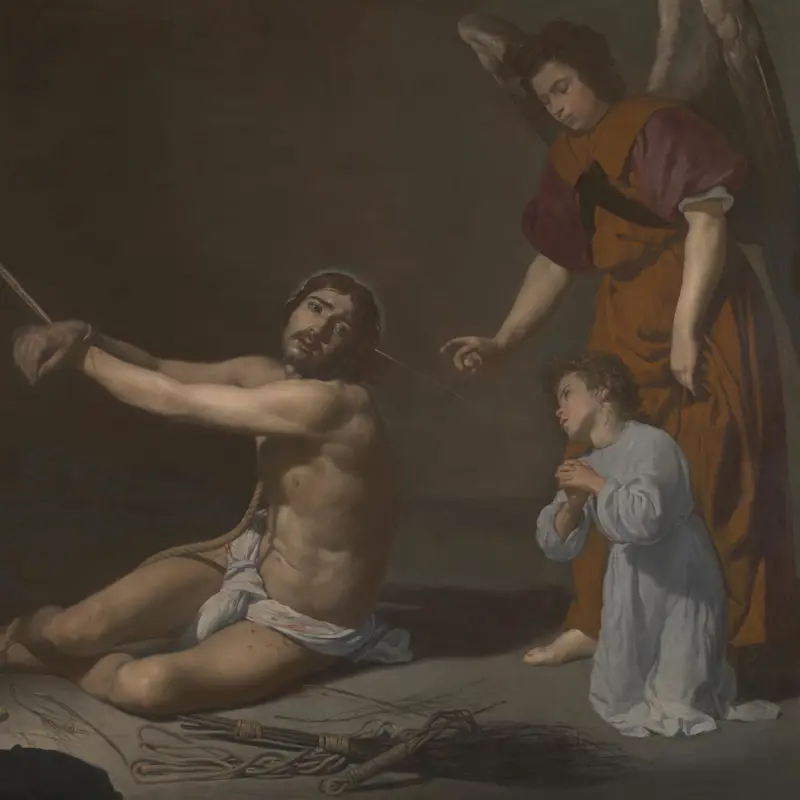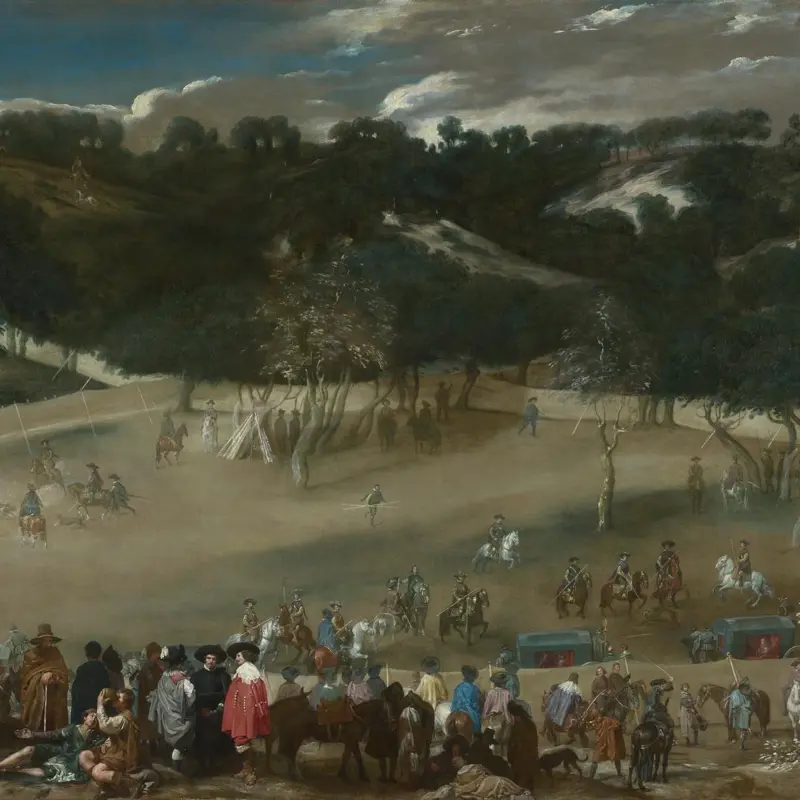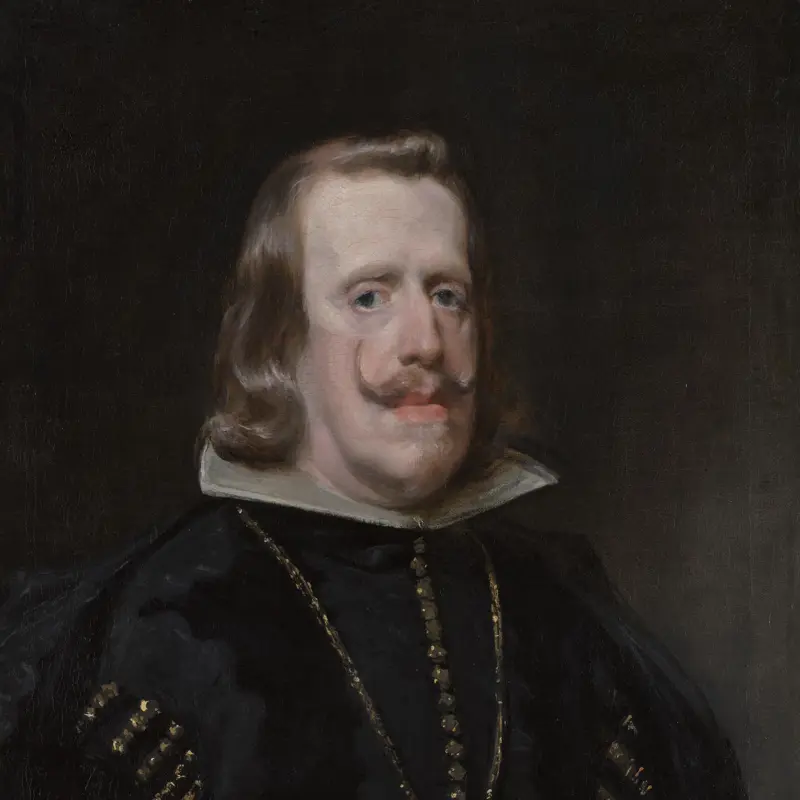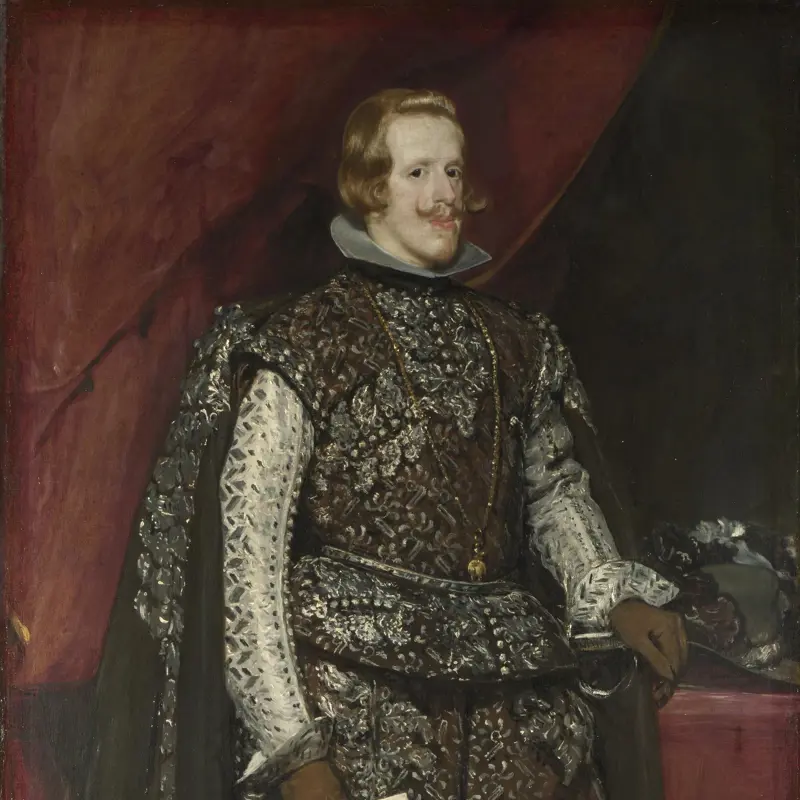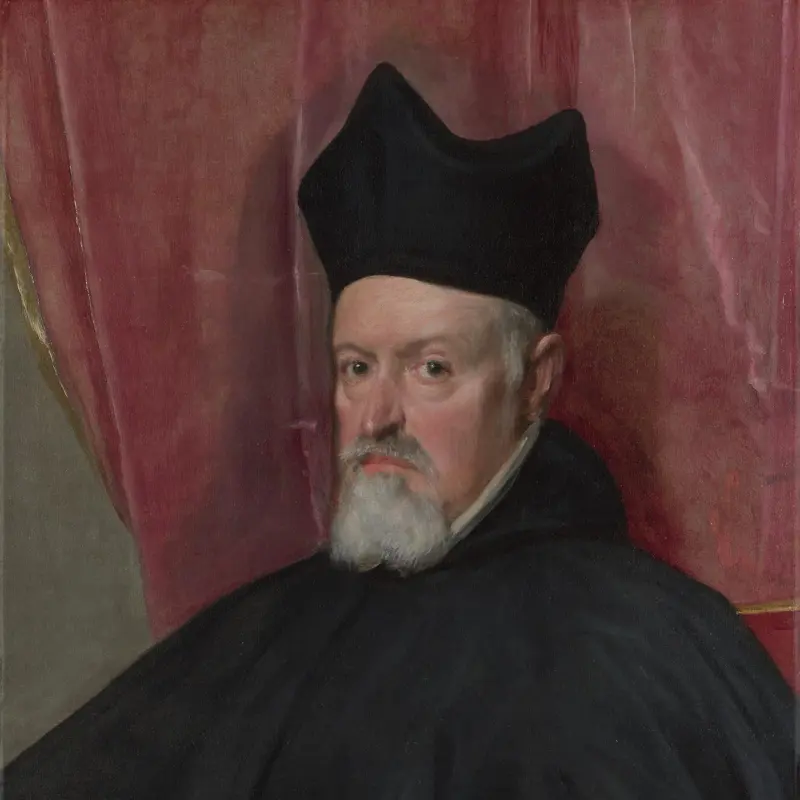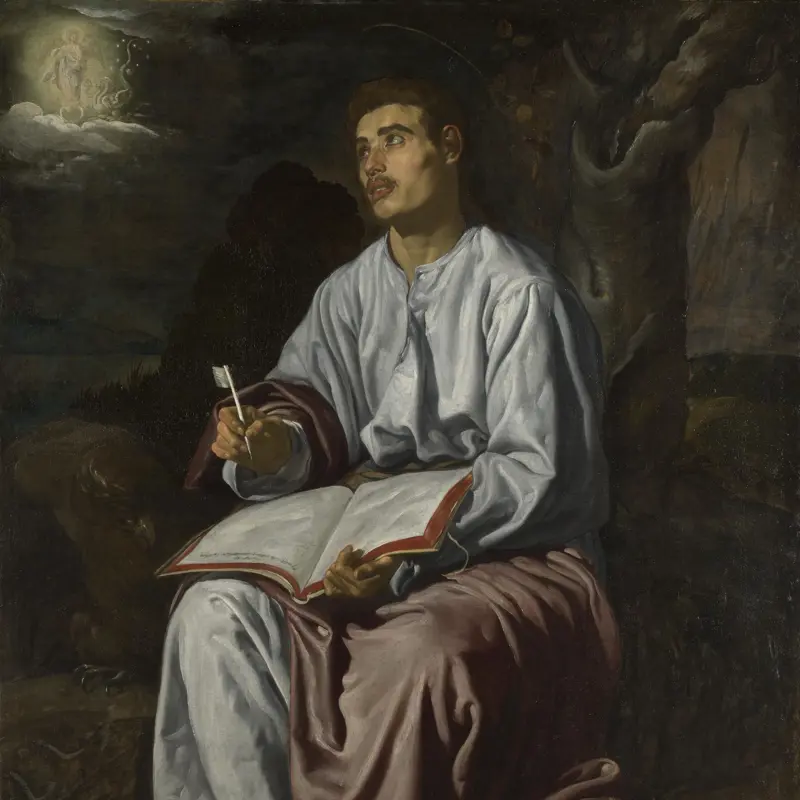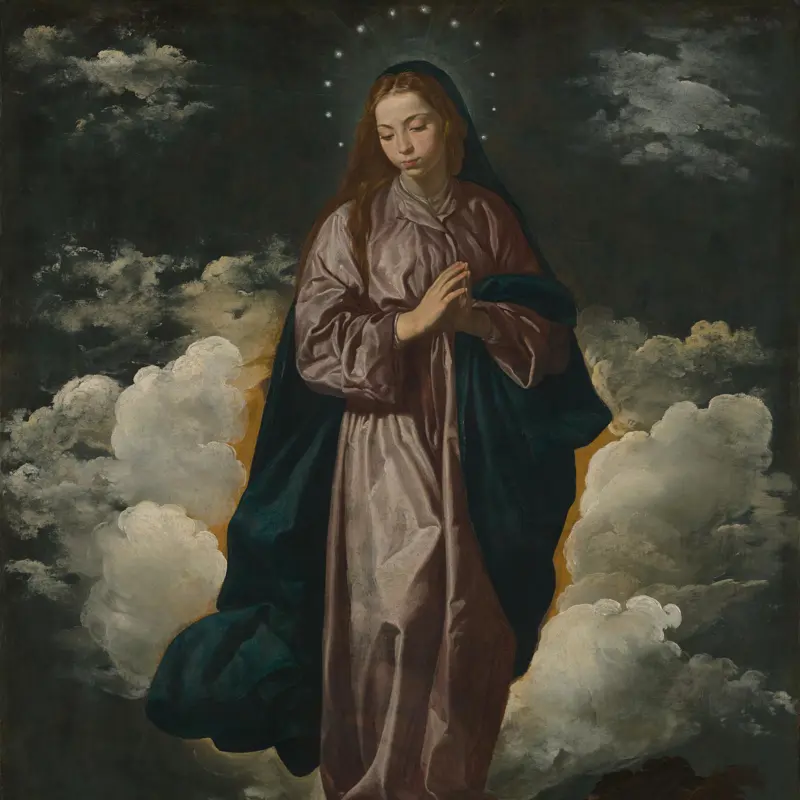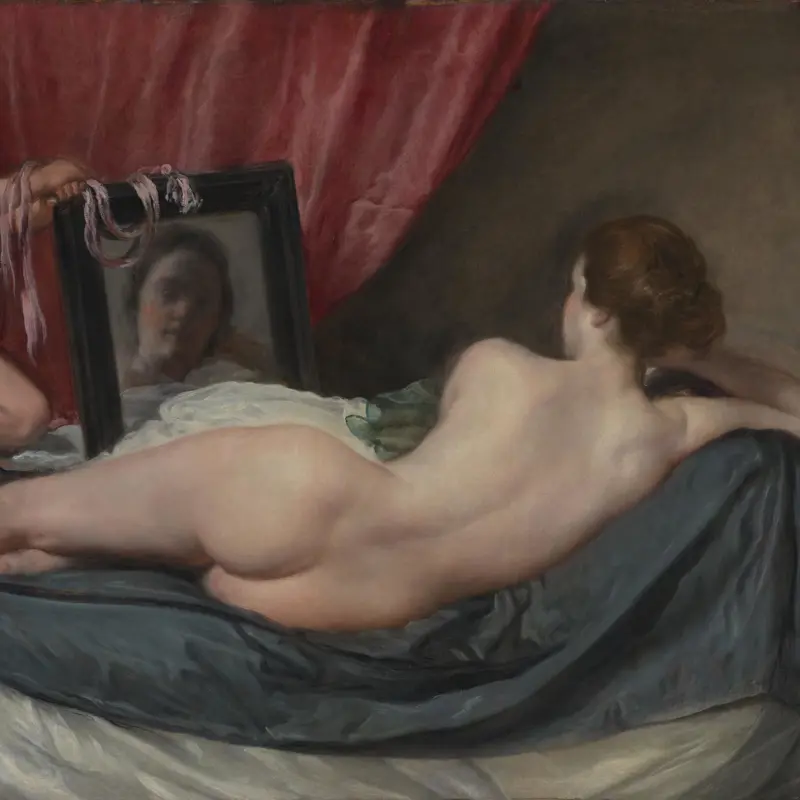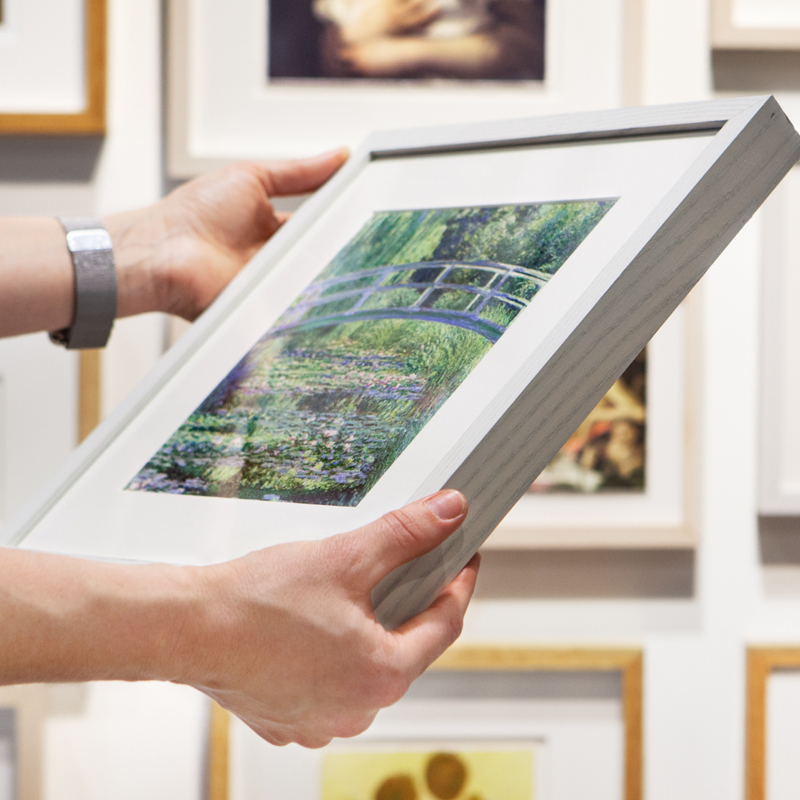Diego Velázquez, 'Christ in the House of Martha and Mary', probably 1618
About the work
Overview
A maid pounds garlic in a mortar, and other ingredients lie scattered on the table: fish, eggs, a shrivelled red pepper and an earthenware jug probably containing olive oil. An older woman points towards her, as if giving her instructions or telling her off for working too hard, or she may be drawing our attention to the figures in the background.
The scene visible in the upper right is taken from the New Testament (Luke 10: 38–42). As Mary sits at Jesus’s feet, listening to him, her sister Martha complains that she should not be left to serve the food alone. Christ replies, ‘Mary has taken that good part, which shall not be taken away from her’. We view it through an opening, although it has also been read as a reflection in a mirror or a picture hung on the wall.
The figures in the foreground, dressed in contemporary costume, may be intended as a latter-day Martha and Mary.
Audio description
Listen to an audio description of Diego Velázquez's 'Christ in the House of Martha and Mary'
Transcript
This is a description of 'Kitchen Scene with Christ in the House of Martha' and Mary by Diego Velázquez. It is oil paint on canvas, probably painted in 1618.
It is 60 cm high and just over a metre wide. Its gilded frame is carved in relief, with a pattern of broad stylised leaf-shapes.
The painting is dark, in a palette of bitter browns and earthy tones, with silvery whites. It depicts a dim kitchen interior, with light entering from the left.
Filling the left half of the composition, are two women. They are shown from the hips upwards, turned towards a table top. The table fills the lower right half of the painting and is laid with food being prepared. The younger of the two women is at the edge of this table, the other woman behind her. In the upper right corner of the composition is a squarish framed section. Its width about one third of the whole picture, it depicts another scene, on a smaller scale. Its relationship to the rest of the painting isn’t immediately clear.
The younger woman is grinding something in a cylindrical pestle of cool shiny metal. She grasps the mortar with her reddened fist, paused in her work to look directly out at us. She wears a plain, chestnut brown fitted jacket, fastened up to the neck. Deep shadows fall on the folds of her sleeve, which is pulled up to reveal a sturdy forearm. At her waist, the beginnings of a thick woollen skirt. Her dark hair is covered by a wide white headband. Her expression is heavy, cheeks ruddy, and her eyes without shine.
The much older woman is looking over her shoulder. A white cloth covers her head and shoulders, allowing a glimpse of grey hair above a wrinkled forehead. She is clothed in deep brown. Her eyes are in shadow, as she reaches in front of the younger woman, gesturing with a pointed finger.
The items on the table are painted with astonishing naturalism. Furthest to the right is a black, glazed plate, with two gleaming white eggs next to an overturned metal spoon. Behind the eggs is an earthenware jug, half glazed, with a simple handle. In the centre of the table is a second, larger plate of four silvery, glistening fish with jellied, staring eyes. They are arranged in pairs, tails touching in the middle, heads spilling out over either side of the plate.
To the left of the fish are the dry papery skins of garlic cloves and a waxy red chilli pepper, possibly what the younger woman is grinding in the mortar and pestle.
The square insert, in the top right, is in a plain dark wood frame, and appears to be on the kitchen wall. It shows a man sitting on a chair turned to the right, in a bare interior. Two women face him, one at his feet, listening intently. He raises his hand in a halting gesture, or one of blessing. This is a scene from the Bible, when Christ reflects on the behaviour of two sisters: Mary prioritises contemplation, while Martha insists on her sister joining her at work in the kitchen.
It is unclear what this picture is. Some understand it as the Bible scene happening in another room, observed through a hole in the wall. Or even a mirror, reflecting another space. Or is it a painting, hanging inside the painting? Velazquez enjoyed playing games with how we perceive objects in space. Here, he might be inviting us to contemplate this biblical scene, set in the context of this kitchen narrative.
Key facts
Details
- Full title
- Kitchen Scene with Christ in the House of Martha and Mary
- Artist
- Diego Velázquez
- Artist dates
- 1599 - 1660
- Date made
- probably 1618
- Medium and support
- oil on canvas
- Dimensions
- 60 × 103.5 cm
- Inscription summary
- Dated
- Acquisition credit
- Bequeathed by Sir William H. Gregory, 1892
- Inventory number
- NG1375
- Location
- Room 30
- Collection
- Main Collection
- Previous owners
- Frame
- 17th-century Italian Frame
Provenance
Additional information
Text extracted from the ‘Provenance’ section of the catalogue entry in Neil MacLaren, revised by Allan Braham, ‘National Gallery Catalogues: The Spanish School’, London 1988; for further information, see the full catalogue entry.
Exhibition history
-
2018Spanish Still LifeCentre for Fine Arts (BOZAR)20 February 2018 - 27 May 2018
-
2020Masterpieces from the National Gallery, LondonThe National Museum of Western Art18 June 2020 - 18 October 2020The National Museum of Art3 November 2020 - 31 January 2021
-
2021Botticelli to Van Gogh: Masterpieces from the National Gallery, LondonNational Gallery of Australia5 March 2021 - 14 June 2021
Bibliography
-
1893London, National Gallery Archive, NG17/5 Annual Reports 1887-1897: The National Gallery Annual Report for the Year 1892, 1893
-
1946L.-P. Fargue, Velázquez, Paris 1946
-
1947N. MacLaren et al., An Exhibition of Spanish Paintings (exh. cat. Arts Council of Great Britain, 11 February - 23 March 1947), London 1947
-
1952Maclaren, Neil, National Gallery Catalogues: The Spanish School, London 1952
-
1958J.R. Buendía, 'La mujer de Velázquez', Goya, 23, 1958, pp. 281-4
-
1965A. Braham, 'A Second Dated Bodegón by Velázquez', The Burlington Magazine, CVII/748, 1965, pp. 362-5
-
1970N. MacLaren and A. Braham, The Spanish School, 2nd edn, London 1970
-
1972B. Mestre Fiol, 'Los tres personajes invisibles de "Las Meninas', Mayurqa: Revista del Departament de Ciències Històriques i Teoria de les Arts, VIII, 1972, pp. 5-20
-
1973B. Mestre Fiol, '"El espejo referencial" en la pintura de Velázquez (Jesús en casa de Marta y María)', Traza y Baza, 2, 1973, pp. 15-36
-
1983M. Helston, Spanish and Later Italian Paintings, London 1983
-
1983B.M. Fiol, 'Jesús en casa de Marta y María y el lenguaje de Velázquez', Boletín de la Real Academia de Bellas Artes de San Fernando, 57, 1983, pp. 155-209
-
1984J.F. Moffitt, 'Terebat in Mortario": Symbolism in Velasquez's Christ in the House of Martha and Mary', Arte Cristiana, 700, 1984, pp. 13-24
-
1985W.B. Jordan and P. Cherry, Spanish Still Life in the Golden Age, 1600-1650 (exh. cat. Kimbell Art Museum, 11 May - 4 August 1985; Toledo Museum of Art, 8 September - 3 November 1985), Fort Worth 1985
-
1987J. Brown and R.L. Kagan, 'The Duke of Alcalá: His Collection and Its Evolution', Art Bulletin, LXIX/2, 1987, pp. 231-55
-
1988Maclaren, Neil, revised by Allan Braham, National Gallery Catalogues: The Spanish School, 2nd edn (revised), London 1988
-
1990J.F. Moffitt, 'Francisco Pacheco and Jerome Nadal: New Light on the Flemish Sources of the Spanish "Picture-within-the-Picture"', Art Bulletin, LXII/700, 1990, pp. 631-8
-
1990A. Domínguez Ortiz, A.E.P. Sánchez and J. Gállego, Velázquez (exh. cat. Museo Nacional del Prado, 23 January - 30 March 1990), Madrid 1990
-
1990M.P. Lozano, 'Fuentes y significado del cuadro "Cristo en casa de Marta" de Diego Velázquez', Cuadernos de Arte e Iconografía, III/6, 1990, pp. 55-69
-
1991M. Pérez Lozano, 'Velázquez en el entorno de Pacheco: Las orimeras obras', Ars longa, II, 1991, pp. 89-102
-
1994E. Langmuir, The National Gallery Companion Guide, London 1994
-
1995W.B. Jordan and P. Cherry, Spanish Still Life from Velázquez to Goya, (exh. cat. The National Gallery, 22 February - 21 May 1995), London 1995
-
1996J. López-Rey, Velázquez: Catalogue Raisonné, Cologne 1996
-
1996D. Davies, 'Velázquez's Bodegones', in M. Clarke (ed.), Velázquez in Seville, Edinburgh 1996, pp. 50-65
-
1997U. Nefzger, 'Wirklichkeit, Wahrheit und Würde bei Velazquez', Pantheon, LV, 1997, pp. 75-90
-
1999J. Baticle et al., Velázquez, Dossier de l'art 63, Dijon 1999
-
1999J. Drury, Painting the Word: Christian Pictures and Their Meanings, New Haven 1999
-
1999M.F. Puerta Rosell, 'Piezas de plata en la pintura española de bodegón', Goya, 269, 1999, pp. 83-92
-
1999A.J. Morales, Velázquez en Sevilla (exh. cat. Monasterio de la Cartuja Santa María de las Cuevas, Salas del Centro Andaluz de Arte Contemporáneo, 1 October - 12 December 1999), Seville 1999
-
2000F. Scheffler, Das spanische Stilleben des 17. Jahrhunderts: Theorie, Genese und Entfaltung einer neuen Bildgattung, Frankfurt am Main 2000
-
2000M.C. Casal, 'The Old Woman in Velázquez's Kitchen Scene with Christ's Visit to Martha and Mary', Journal of the Warburg and Courtauld Institutes, LXIII, 2000, pp. 295-302
-
2000T.L. Glenn, 'Velázquez's Kitchen Scene with Christ in the House of Martha and Mary: An Image Both "Reflected" and to ne Reflected upon', Gazette des beaux-arts, 136, 2000, pp. 21-30
-
2001
C. Baker and T. Henry, The National Gallery: Complete Illustrated Catalogue, London 2001
-
2001K. Hellwig, 'Las firmas de Velázquez', Boletín del Museo del Prado, XIX/37, 2001, pp. 21-46
-
2001M. Morán Turina, 'Velázquez, la pintura y el teatro del Siglo de Oro', Boletín del Museo del Prado, XIX/37, 2001, pp. 47-71
-
2001X. Brooke and P. Cherry, Murillo: Scenes of Childhood (exh. cat. Dulwich Picture Gallery, 14 February - 13 May 2001; Alte Pinakothek, 23 May - 26 August 2001), London 2001
-
2002A. Vergara, 'Velázquez and the North', in S.L. Stratton-Pruitt (ed.), The Cambridge Companion to Velázquez, Cambridge 2002, pp. 48-67
-
2004J. Boyd and P.F. Esler, Visuality and Biblical Text: Interpreting Velázquez's 'Christ with Martha and Mary' As a Test Case, Florence 2004
-
2004A.J. Morales and C. Sánchez de las Heras (eds), Symposium Internacional Velázquez, Actas, 8-11 de noviembre, Sevilla, 1999, Seville 2004
-
2006T.J. Tiffany, 'Velázquez's "Bodegones" and the Art of Emulation', Anuario del Departamento de Historia y Teoría del Arte, XVIII, 2006, pp. 79-95
-
2006B. Vischer, 'Cibus et potus: Velázquez' "Alte Köchin"', Zeitschrift für Kunstgeschichte, LXIX, 2006, pp. 305-41
-
2006D. Carr (ed.), Velázquez (exh. cat. The National Gallery, 18 October 2006 - 21 January 2007), London 2006
-
2007J. Portús, Velázquez's Fables: Mythology and Sacred History in the Golden Age (exh. cat. Museo Nacional del Prado, 20 November 2007 - 24 February 2008), Madrid 2007
-
2008F. Checa, Velázquez: The Complete Paintings, Antwerp 2008
-
2008T.J. Tiffany, 'Light, Darkness, and African Salvation: Velázquez's "Supper at Emaus"', Art History, III/1, 2008, pp. 33-56
-
2008S. Schroth and R. Baer, El Greco to Velázquez: Art during the Reign of Philip III (exh. cat. Museum of Fine Arts, 20 April - 27 July 2008; Nasher Museum of Art, 21 August - 9 November 2008), Boston 2008
About this record
If you know more about this work or have spotted an error, please contact us. Please note that exhibition histories are listed from 2009 onwards. Bibliographies may not be complete; more comprehensive information is available in the National Gallery Library.

